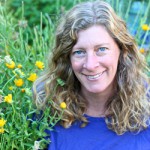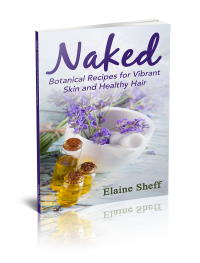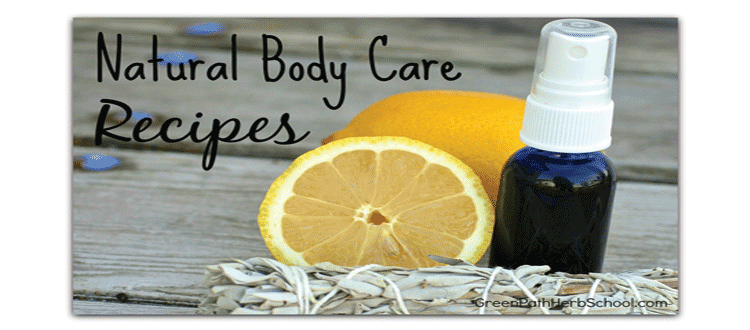Natural Body Care Recipes: How to Make Your Own
 |
|
Elaine Sheff |
Many products that we put on our skin can be absorbed directly into our bodies and some body care products claiming to be “natural” actually contain harsh chemicals. This is why it is very important to get educated about skin care ingredients and think carefully about what we use on our skin. Often, simple, basic recipes made with ingredients we can pronounce are the best. I hope you enjoy these recipes. I welcome you to get creative, experiment, and have fun!
Note: These recipes include essential oils. Not all people tolerate essential oils well. Click here to see Elaine’s note on using essential oils.
Dry Skin Lotion
Ingredients:
Oil-based ingredients:
Measure by volume:
- 1 cup cold pressed olive oil
- 1/4 cup jojoba oil
- 2 tablespoons rosehip seed oil
- 2 tablespoons avocado oil
- 2 teaspoons lanolin (optional)
- 1⁄2 teaspoon vitamin E oil or 1 1⁄4 teaspoon rosemary antioxidant
- 30 drops lavender essential oil (optional)
- 30 drops cultivated sandalwood essential oil (optional)
- 20 drops clary sage essential oil (optional)
Measure by weight:
- 4 ounces coconut oil
- 1 ounce beeswax
Water-based ingredients:
Measure by volume:
- 1 cup distilled water
- 1/2 cup rose hydrosol
- 1/2 cup aloe vera gel
- 1⁄2 teaspoon citric acid
You Will Need:
- Scale
- Large bowl
- Measuring cups and spoons
- Double boiler
- Blender
- Spatula
- Jars
- Labels
Directions:
- Make sure all utensils and tools are disinfected before use. You can do this by boiling them, running them through a dishwasher or soaking them in a bleach solution (1 tablespoon of bleach to 1 gallon of water)
- Combine all “water” ingredients in a bowl and set aside.
- You can add 1 teaspoon arrowroot powder to the water-based ingredients if you would like a lotion with a little less oily feel to it. Whisk well until fully incorporated.
- In a double boiler, melt the beeswax.
- Add the almond oil, olive oil, coconut oil, lanolin, and vitamin E oil to the double boiler and heat until melted. Stir well.
- Pour the oils into a blender and let them cool to room temperature.
- When the oil is at room temperature, add the essential oils.
- After all ingredients have come to room temperature, you can begin mixing.
- Turn the blender on high and slowly drizzle in the “water” ingredients until the water is no longer blending in well, or the mixture gets too thick to blend.
- Sometimes more of the water mixture can be mixed into the emulsion by hand.
- Pour into sterilized jars. I like to use a glass pump bottle so I don’t put my hands in the lotion and increase the risk of contamination.
- Let cool completely before capping.
- Store extra in the refrigerator.
- This rich recipe can be used on the face or the body.
Happy Feet Lotion Bar:
Do you have cracked or dry feet? This solid lotion bar will keep your tootsies looking and feeling their best, while reducing foot odor! It can be used in the evening before bed and is especially hydrating to use after a bath or shower. This bar also works well for dry hands, and rough cuticles and elbows.
Ingredients:
Measure by weight:
- 5 ounces beeswax
- 7 ounces cocoa butter
- 2 ounces shea butter
- 2 ounces mango butter
- 4 ounces almond oil
Measure by volume:
- 1 tablespoon baking soda
- 1 teaspoon vitamin E oil
- 1 teaspoon tea tree essential oil (optional)
You Will Need:
- Scale Double boiler
- Metal spoon
- Glass Pyrex measuring cup
- Molds including candy molds, soap molds or even ice cube trays.
Directions:
- Melt the beeswax in a double boiler.
- Add the cocoa butter and coconut oil and stir until melted.
- Add the almond oil and vitamin E oil and stir once again until melted.
- Add your essential oil(s) and stir well.
- Wipe off the bottom of the double boiler to remove any excess water.
- Pour into a Pyrex measuring cup.
- Pour into molds.
- Let cool and then pop the bars out of the mold.
- I like to store bars in small metal tins for portability. They are wonderful to travel with and go easily into a purse or backpack.
White Sage Deodorant:
Most antiperspirants have aluminum, synthetic fragrances and propylene glycol in them. So, what’s the big deal? Research suggests that aluminum-based ingredients, when applied frequently near the breast, may be absorbed and cause estrogen-like effects on the body. Synthetic fragrances can have a negative affect on the central nervous system and can cause symptoms such as depression, hyperactivity and irritability. Studies have shown propylene glycol is toxic when ingested and can cause brain, liver and kidney abnormalities. What’s a person to do? How about making your own natural deodorant with herbs and essential oils that reduce odor and sweating? Note: white sage (Salvia apiana) is on the United Plant Saver’s “To Watch” list, but can be cultivated. Please make sure that you getting a cultivated source, such as from Herb Pharm.
Ingredients:
Measure by volume:
- 1 ounce (2 tablespoons) witch hazel extract
- 1 ounce (2 tablespoons) white sage tincture (cultivated)
- 10 drops sage essential oil
- 10 drops cedar essential oil
- 10 drops lemon essential oil
You Will Need:
- Measuring cups
- Measuring spoons
- Bowl or jar
- Glass bottles (I like a spray bottle for easy application)
- Labels
Directions:
- Mix all ingredients together well.
- Pour into a dark glass spray bottle and label.
- Shake well before applying under the arms.
- This recipe can also be sprayed on the feet.
Forest Grove Bath Melts:
This recipe is from my new book Naked: Botanical Recipes for Vibrant Skin and Healthy Hair. One of the most basic recipes in the book, these bars are a simple blend of sweet almond oil, cocoa butter and essential oil. You can add herbs or natural colors as well, or make them unscented by leaving out the essential oils (the cocoa butter itself smells like chocolate). Once in the bath, you can rub them on your skin for extra hydration. They leave your skin soft and silky and add a moisturizing element to the bath for dry, irritated skin or eczema.
Ingredients:
Measure by weight:
- 8 ounces cocoa butter
Measure by volume:
- 1⁄2 cup sweet almond oil
- 60 drops orange essential oil
- 30 drops cedar essential oil
- 30 drops fir essential oil
You will need:
- Scale
- Measuring cup
- Double boiler
- Spoon
- Molds ( I find that small glycerin soap molds work well, but you can also use small muffin pans, ice cube trays or candy molds.)
- Glass jars or containers
- Labels, jars or bags
Directions:
- In a double boiler, melt the cocoa butter.
- Add the almond oil and stir until melted.
- Take off the stove and add the essential oils. At this point, you can also add some dried lavender flowers if you wish.
- Pour into molds and let cool completely. This recipe takes a while to cool and solidify. You can put the molds in the refrigerator to speed the process.
- To use, get in the tub, add a bath melt and watch it melt. Kids love this part!
- Gently rub the oils into your skin.
- Be careful when exiting the tub as the oil can make surfaces slippery!
- These bath melts can also be used in a foot bath.
I hope you enjoy these recipes! Lastly, I want to remind you of something I think is ultimately important when we think of beauty care products. True beauty doesn’t come from any body care product. It comes from inside. It comes from our actions and our interactions. May you have a truly beautiful day!
Download a printable copy of these recipes. Click here.
About Essential Oils
Essential oils are the scent molecules of plants. Synthetic fragrances have either been chemically created (mostly from petroleum), or started as naturally derived fragrances and have had their chemical structure modified. They can irritate the skin, respiratory and nervous systems, as well as creating problems for those with chemical sensitivities. I actually think of them as air pollution. Essential oils, on the other hand, are healing to the body. They are good for the skin, respiratory system, mind and mood. Plants make essential oils for various reasons. Essential oils help plants attract pollinators, compete with other plants, prevent microbial infections and deter herbivores and insects. There are a lot of poor quality oils on the market. Make sure you purchase unadulterated, pure, therapeutic essential oils. I recommend looking for oils that are tested with gas chromatography, which helps us make sure oils are authentic by showing us the chemical composition of an essential oil. This composition is like a “fingerprint” unique to that botanical species only. Please research any oil before use. Not all people tolerate essential oils well. To determine if an oil is safe to use on your skin, you can do a patch test on inner wrist, applying the diluted oil and the looking for any redness or irritation. Be cautions using essential oils with babies and small children, elders, people with allergies and during pregnancy or nursing. Some essential oils, such as citrus oils, can cause photosensitivity on the skin when exposed to ultraviolet light.

The author of five books on herbal medicine and healing, clinical herbalist Elaine Sheff has been passionate about sharing herbal knowledge for over 25 years. Elaine’s most recent book is Naked: Botanical Recipes for Vibrant Skin and Healthy Hair. She is the Co-Director of Green Path Herb School, where she strives to inspire and empower students and clients to remember their connection to the earth, the plants and their own healing process. As a certified Instructor of the Natural Family Planning and Fertility Awareness Methods, Elaine has helped many couples to avoid or achieve pregnancy naturally. An artist and writer, Elaine has written numerous articles about her family’s journey with epilepsy and a special needs child. You can often find her bent over an herb in her garden or marveling at small flowers in mountain meadows with her husband and sons.



